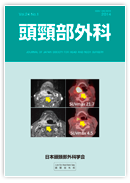Volume 24, Issue 1
Displaying 1-20 of 20 articles from this issue
- |<
- <
- 1
- >
- >|
-
2014Volume 24Issue 1 Pages 1-8
Published: 2014
Released on J-STAGE: September 10, 2014
Download PDF (842K)
-
2014Volume 24Issue 1 Pages 9-14
Published: 2014
Released on J-STAGE: September 10, 2014
Download PDF (2027K) -
2014Volume 24Issue 1 Pages 15-18
Published: 2014
Released on J-STAGE: September 10, 2014
Download PDF (522K)
-
2014Volume 24Issue 1 Pages 19-22
Published: 2014
Released on J-STAGE: September 10, 2014
Download PDF (589K)
-
2014Volume 24Issue 1 Pages 23-26
Published: 2014
Released on J-STAGE: September 10, 2014
Download PDF (541K) -
2014Volume 24Issue 1 Pages 27-31
Published: 2014
Released on J-STAGE: September 10, 2014
Download PDF (1240K)
-
2014Volume 24Issue 1 Pages 33-37
Published: 2014
Released on J-STAGE: September 10, 2014
Download PDF (412K)
-
2014Volume 24Issue 1 Pages 39-43
Published: 2014
Released on J-STAGE: September 10, 2014
Download PDF (756K) -
2014Volume 24Issue 1 Pages 45-49
Published: 2014
Released on J-STAGE: September 10, 2014
Download PDF (669K) -
2014Volume 24Issue 1 Pages 51-55
Published: 2014
Released on J-STAGE: September 10, 2014
Download PDF (593K) -
2014Volume 24Issue 1 Pages 57-61
Published: 2014
Released on J-STAGE: September 10, 2014
Download PDF (550K) -
2014Volume 24Issue 1 Pages 63-68
Published: 2014
Released on J-STAGE: September 10, 2014
Download PDF (931K) -
2014Volume 24Issue 1 Pages 69-73
Published: 2014
Released on J-STAGE: September 10, 2014
Download PDF (702K) -
2014Volume 24Issue 1 Pages 75-81
Published: 2014
Released on J-STAGE: September 10, 2014
Download PDF (1152K) -
2014Volume 24Issue 1 Pages 83-88
Published: 2014
Released on J-STAGE: September 10, 2014
Download PDF (797K) -
2014Volume 24Issue 1 Pages 89-93
Published: 2014
Released on J-STAGE: September 10, 2014
Download PDF (783K) -
2014Volume 24Issue 1 Pages 95-99
Published: 2014
Released on J-STAGE: September 10, 2014
Download PDF (642K) -
2014Volume 24Issue 1 Pages 101-107
Published: 2014
Released on J-STAGE: September 10, 2014
Download PDF (595K) -
2014Volume 24Issue 1 Pages 109-113
Published: 2014
Released on J-STAGE: September 10, 2014
Download PDF (960K) -
2014Volume 24Issue 1 Pages 115-121
Published: 2014
Released on J-STAGE: September 10, 2014
Download PDF (1019K)
- |<
- <
- 1
- >
- >|
